Meals in space. |
||
Items that are not secured simply float around the space station. It is not the absence of gravity the causes weightlessness but the fact that all things in the space station are in free fall.
|
|
|
Why does food float about the space craft? Why is it that everything on-board the Space Station is dehydrated? Explain how cooking in space differs from cooking here on earth. Bread and fizzy drinks are also not permitted but for totally different reasons. Research and suggest what the reasons might be.
|
||
View the video on the right. Try to get an understanding of the problems faced by astronaut living in space when it comes to preparing and eating a simple meal. Start by completing this task in identifying some of the activities that you perform day-to-day in your kitchen and how might they differ if you performed them on the International Space Station (ISS). It may be impossible to perform some of these tasks on the ISS. |
sourced from https://www.youtube.com/watch?v=E36F4XG5zcY at 9.25 6/10/20 |
|
| Some things to consider are listed below. There are many more challenges for you to over come though. The cost of sending one kilogram of food into space with SpaceX Falcon 9 is $2,720. So it is important to reduce the weight of food launched into space by dehydrating it where ever possible. Water is readily available on the ISS and is collect from breath and sweat, urine from people and research animals, and runoff from sinks and showers. In other words it is recycled in every way possible. | ||
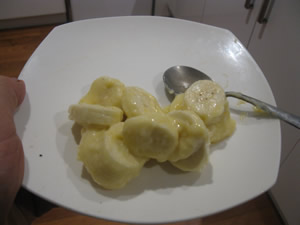 |
On the ISS food doesn't behave the same way as they do here on earth. Sometimes a thick creamy custard might be used to bind pieces of fruit together so they can be scooped out of their container with a spoon and not fly away. Bananas, as shown on the left, can be served on a plate as long as they are mixed with custard which has the added benefit of holding the fruit onto the plate and also on the spoon. Custard is ideal as it can be dehydrated and stored for long periods of time. | |
| Mixing and rehydrating the custard is not as easy as placing the powder in a bowl, adding water and stirring until thickened. Don't forget you a simulating weightlessness. You may wish to be inventive as NASA scientists are always solving problems in different forms. | ||
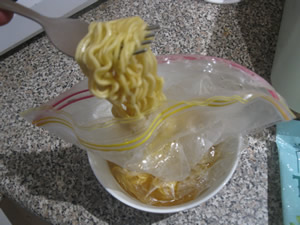 |
Dry noodles can be sealed in a zip-lock bag and eaten with a fork. Rehydrating though can be a little tricky. Remember you can not just pour water from the tap into the bag. Think of possible solutions. Now how will you warm up the noodles after you have mixed them with water? When using the microwave always ask Mum or Dad or an adult. Never cook anything for more than 30 seconds. |
|
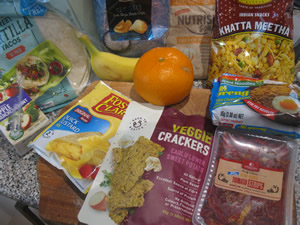 |
When ever you are selecting food from the supermarket to use in preparing an astronaut's snack think of things that: Now you will notice some fresh fruit in the selection of foods shown on the left. Yes a little fresh fruit is allowed and can be transported to the ISS. It is good for the psychological wellbeing of the astronauts. |
|
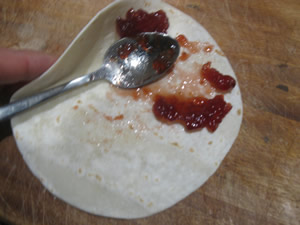 |
Tortillas are preferred over bread. They create no crumbs and can last longer than read. They are used by astronauts to wrap their food in and be creative. Jam can also be spread onto the tortilla with ease on the ISS. Suggest why jam is OK to use on the ISS without any precautions. | |
 |
Suggest why this food is not likely to be found on the ISS. Is it that it is difficult to drink? Explain.
Powdered spices are absolutely forbidden. These spices, however, are not. Suggest a reason why. |
|
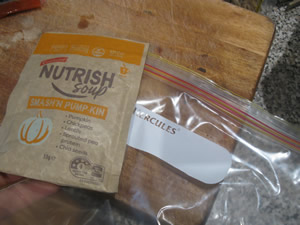 |
Soup and zip-lock bag make for a really good snack. Suggest reasons why this is so. |
|
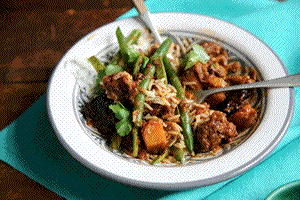 |
Now finally, think of how food is served. Can you simply place it on a plate and leave it there until the astronaut is ready to eat? No. Suggest a logical solution to this problem. |
|
Now here is an interesting demonstration on why it is important for the ISS to have the right amount of air pressure. Sure it is important so that the astronauts can breath but there is another reason to do with boiling, or heating of water. Watch the video on the left. What is done to the syringe to lower the air pressure inside? Air pressure, generally speaking, is the force exerted by the air particles on the walls of the syringe as they collide with force. Use your knowledge of particle theory to explain why the air pressure drops when the plunger is pulled out. |
||
Now here is a task for you. This task involves problem solving using your knowledge of what you know about space. - Photograph or video (no faces please) yourself preparing an astronaut's meal. You must be mindful of what is and is not possible in space. Your peers will evaluate your method of preparing the meal (snack) to see if it is plausible in a weightless environment. - Next photograph or video a family member eating the snack or meal, once again no faces please. Describe on how the meal is being eaten and explain why or why not this way of eating can or can not be performed in space. |
||